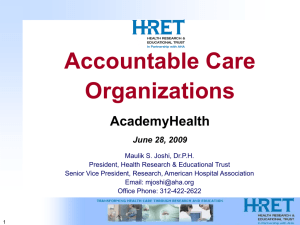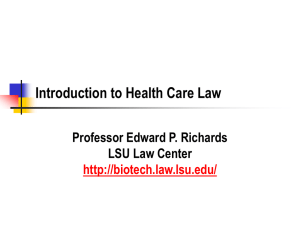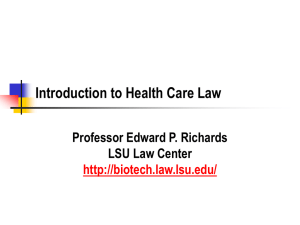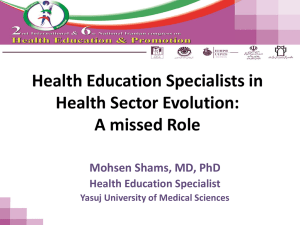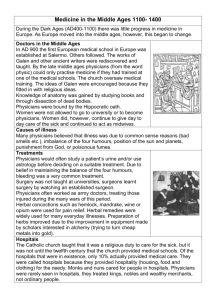History and Evolution of Medical Care Institutions Professor Edward P. Richards
advertisement
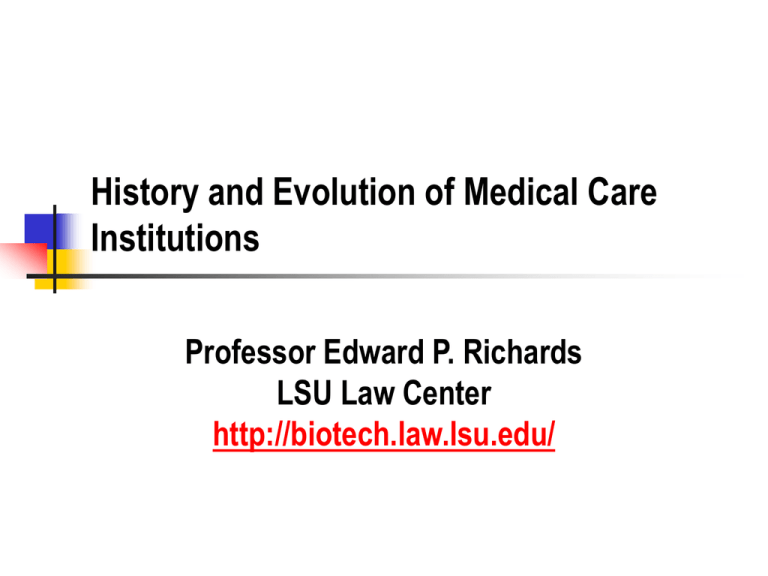
History and Evolution of Medical Care Institutions Professor Edward P. Richards LSU Law Center http://biotech.law.lsu.edu/ Key Issues Scientific medicine is about 120 years old Technology based medicine is less than 60 years old Doctors are not scientists and many do not practice scientific medicine. Modern medicine is shaped by its history Health care finance shapes medical care Special interests undermine cost-effective care Financial tinkering destabilized primary health care 2 Critical Dates in Medicine 1400s Birth of Hospitals Places where nuns took care of the dying No medical care – against the Church’s teachings No sanitation – assured you would die 4 Early 16th Century Paracelsus Transition From Alchemy 5 Mid 16th Century Andreas Vesalius Accurate Anatomy 6 Early 17th Century William Harvey Blood Circulation – the body is dynamic, not static 7 1800 Edward Jenner Smallpox and the notion of vaccination 8 1846 William Morton - Ether Anesthesia 9 1849 Semmelweis Childbed Fever and sanitation Scientific Method Controlled Studies 10 1854 John Snow Proved Cholera Is Waterborne Basis of the public sanitation movement 11 1860-1880s - Development of the Germ Theory Louis Pasteur Simple Germ Theory Vaccination For Rabies Pasteurization to kill bacteria in milk Joseph Lister Antisepsis – surgeons should wash their hands and everything else, then use disinfectants Koch Modern Germ Theory 12 Sanitation Movement - Modern Public Health: 1850s - 1900s Lead by the Shattuck Report on Sanitation in Boston - 1850 Waste water disposal Drinking water treatment Pasteurization of milk Food sanitation The Jungle - 1905 13 The Business of Medicine in the 1800s Physicians are Solo Practitioners Most Make Little Money Have Limited Respect No bar to entry to profession Most medical schools are diploma mills Limited or no licensing requirements Cannot make capital investments Training Medical equipment and staff 14 Transition to Modern Medicine and Surgery Surgery Starts to Work in the 1880s Surgery Can Be Precise - Anesthesia Patients Do Not Get Infected - Antisepsis 16 Effect on Licensing and Education Once there are objective differences (people live) between qualified and unqualified docs, people care You can make more money with better training You can make more money with better equipment and facilities Effective Medicine Drives Licensing Licensing Limits Competition Physicians Start to Make Money Allows capital expenditures 17 The Tipping Point - 1910 About 1910, going to the doctor, and particularly the hospital, shifted from being more dangerous than avoiding them to increasing your chance of survival. Flexner Report - standardized medical education and shaped the modern training system 18 Legal Limits on Physician Practice Organization - 1920s Corporate practice of medicine Physicians working for non-physicians Concerns about professional judgment Real Concern Was Laymen Making Money off Physicians Banned in most states Docs pushed the bans 19 Traditional Impact of Corporate Bans Physicians Do Not Work for Non-Governmental Hospitals Contracts Governed by Medical Staff Bylaws Sham of “Buying” Practices Physicians Contract With Most Institutions Charade of Captive Physician Groups Managed Care Companies Contact With Group Group Enforces Managed Care Company’s Rules Physicians Can Be As Ruthless As Anyone 20 Impact on Physician Practices Corporate practice bans limited competitors to physician practices Physicians had no incentive to form their own large integrated practices Sole Proprietorships and Partnerships A few exceptions - Kaiser The legal impact is that these small groups were subject to the antitrust laws, making it difficult to negotiate with health insurers in the 1980s 21 From L'Hotel-Dieu to High Tech The Evolution of Hospitals From Nuns to MBAs Reformation of Hospitals Paralleled Changes in the Medical Profession Began in the 1880s Shift From Religious to Secular Began in the Midwest and West Not As Many Established Religious Hospitals Today, Religious Orders Still Control A Majority of Hospitals 23 Technology in Hospitals - The Advantage of Hospital Care over Home Care Driven by antisepsis - homes were safer before antisepsis Started With Surgery Medical Laboratories Bacteriology Microanatomy Radiology Services and Sanitation Attract Patients Internal Medicine Obstetrics Patients 24 Post WW II Technology Ventilators (Polio) Electronic Monitors Intensive Care Hospitals Shift From Hotel Services to Technology Oriented Nursing 25 Post World War II Medicine Conquering Microbial Diseases Vaccines Antibiotics Chronic Diseases Better Drugs Better Studies Childhood Leukemia 26 Effect of Medical Science on Hospital Care 1930s Few effective treatments means no cures other than surgery Long stays, hospitals act as nursing homes Care is nursing and palliative Post-1960s Many effective treatments Much shorter stays - expansion of nursing homes Most care is technological 27 Joint Commission on Accreditation of Hospitals 1950s American College of Surgeons and American Hospital Association Now Joint Commission (on Accreditation of Anything that Makes Money in Health Care) Split The Power In Hospitals Medical Staff Controls Medical Staff Administrators Control Everything Else Enforced By Accreditation Depends on Medicare/Medicare waiver Seldom pulls accreditation 28 Changes in Hospital Financial Models Pre-1970s Mostly Charitable Built on donations, not debt or bonds Reduced operating costs and pressure on occupancy Post 1970s Debt Stock market - pressure for performance Huge pressure on occupancy and profitability 29 EMTALA and the Duty to Treat - 1986 Traditionally hospitals could, in theory, refuse to treat patients without money Actually limited to patients with no legal relationship to the hospitals Emergency Medical Treatment and Active Labor Act of 1986 Must evaluate all patients seeking treatment Must treat or properly transfer all needing treatment to save life or limb or in active labor Can charge, but no government funding for unpaid care 30 Contemporary Hospital Organization Classic Corporate Organizations CEO Board of Trustees Has Final Authority Part of Conglomerate Medical Staff Committees Tied To Corporation by Bylaws Headed by Medical Director Raises Conflict of Interest/Antitrust Issues 31 Medical Staff Bylaws Contract Between Physicians and Hospital Not Like the Bylaws of a Business Selection Criteria Contractual Due Process For Termination Negotiated Between Medical Staff and Hospital Board Limits corporate control as compared to employee models 32 Specialty Hospitals Traditional hospitals were general care Children's and maternity hospitals Broadened to areas such as hearts, orthopedics, etc. Complex care is safer when regionalized into high volume centers Better care at lower prices 33 The Real Specialty Hospital Business Model Do not do money losing services Do not take uninsured patients Shift the most valuable patients from community hospitals, dump the rest back to the community hospital No EMTALA requirements if no ER Doc owners control admissions Huge conflict of interest No regulation in LA, limited elsewhere One on every corner, no regionalization Increase unnecessary surgery 34

